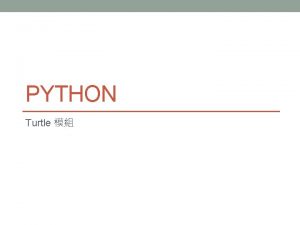PYTHON TURTLE WORLD CHAPTER 4 FROM THINK PYTHON














- Slides: 14

PYTHON TURTLE WORLD : CHAPTER 4 FROM THINK PYTHON HOW TO THINK LIKE A COMPUTER SCIENTIST

DOWNLOAD SWAMPY Swampy is a collection of python files/libs that create a Logo like turtle environment. You first need to download the files from http: //www. greenteapress. com/thinkpython/swampy/ Click on Install Swampy and do the appropriate install based on your OS. It also requires the installation of Tkinter I download swampy-2. 1. 7. zip Decompress and move swampy directory to C: Python 27Libsite-packages if you are using Python 2. 7. 6 Note: You can do all this in Linux, Macintosh or Windows

TEST SWAMPY Run the python GUI and create a new file and save it in a directory of your choice testit. py. Pick a directory name like python. Programs Type in the following program and run it You should get a popup window that shown on the right. The little turtle has drawn a square

TEST PROGRAM Required for this lab only! import sys. path. append("Y: Bolin College of Science and MathematicsRichard Simpsonsite-packages") #Test Turtle. World from swampy. Turtle. World import * world = Turtle. World() bob = Turtle() Create a turtle named bob. Initial heading is east i. e. 0 bob. delay=. 01 fd(bob, 100) 90 rt(bob, 90) fd(bob, 100) heading rt(bob, 90) fd(bob, 100) 180 0 wait_for_user() 270

TURTLE COMMANDS bk(self, dist=1) unbound Turtle method Moves the turtle backward by the given distance. fd(self, dist=1) unbound Turtle method Moves the turtle foward by the given distance. lt(self, angle=90) unbound Turtle method. Turns left by the given angle. pd(self) unbound Turtle method Puts the pen down (active). pu(self) unbound Turtle method Puts the pen up (inactive). rt(self, angle=90) unbound Turtle method Turns right by the given angle. set_color(self, color) unbound Turtle method Changes the color of the turtle.

MORE COMMANDS HTTP: //WWW. GREENTEAPRESS. COM/THINKPYTHON/SWAMPY/TURTLEWORLD. HTML draw(self) Draws the turtle. get_heading(self) Returns the current heading in degrees. 0 is east. get_x(self) Returns the current x coordinate. get_y(self) Returns the current y coordinate. set_pen_color(self, color) Changes the pen color of the turtle. step(self) Takes a step. Default step behavior is forward one pixel. die(self) Removes the animal from the world and undraws it. undraw(self) Undraws the animal. Attributes: x: position y: position r: radius of shell heading: what direction the turtle is facing, in degrees. 0 is east. pen: boolean, whether the pen is down color: string turtle color delay: delay between instructions The can be set directly For example self. x = 10

LETS DRAW A SQUARE WITH A LOOP from swampy. Turtle. World import * world = Turtle. World() bob = Turtle() Create a turtle named bob. Initial heading is east i. e. 0 and initial location is at (0, 0) bob. delay=. 01 for i in range(4): This is the for loop fd(bob, 100) rt(bob, 90) wait_for_user() These 2 instructions are performed 4 times Four space indention is required!!!

LETS DRAW THINGS Write a program to draw each of the following. Use for loop! 1. 2. 3. 4. Remember you can bob. x=0 and bob. y=0

LETS USE FUNCTIONS TO HELP US HERE Fill in the following function so that it draws a square when called. It has to parameters self and length. Self is the turtle name and length is the length of the edge of the square def square(self, length): fd(self, length) rt(self, 90) # Run it square(bob, 200) #type this in and test it out.

HOW ABOUT DRAWING A REGULAR POLYGON OF N SIDES? If N = 6 What is this angle? What is the angle in terms of N? 360. 0/N

COMPLETE THE FOLLOWING def polygon(self, n, length) angle = 360. 0/n for i in range(n): fd(self, length) rt(self, angle) # call it polygon(bob, 6) # Advanced problem: Change this so the polygon is drawn centered in the window!!!

DRAW A CIRCLE OF RADIUS R!!!! We will approximate this with the polygon() function we already wrote. def circle(self, radius) How can we use C = 2πr to help us here? Hint: as the value of n ( number of sides of the polygon) gets large n*length_of_edge ≈ C (Do you agree? ) So Pick n to be C/length_of_edge where length_of_edge = 3 (some small value) This way we use only enough edges as are needed!!!

SIMULATING A RANDOM MOVING TURTLE In this project we will first develop a turtle program that creates a turtle the moves around randomly. We first have to pick a random direction the turn to. Python has a built in function called random. We can use it by importing it from random import * Here is an example that returns a number from 0 to 1 x = random() If we want a random number from 0 to 100 we could x = random()*100

THE CODE from swampy. Turtle. World import * from random import * world = Turtle. World() bob = Turtle() bob. delay=. 01 for i in range(1000): # 1000 random steps fd( bob, 3) # the following creates a random # number from -45 to +45 angle = random()*90 -45 rt(bob, angle) die(bob) wait_for_user() 300 steps example
 Ramaniklal ambani
Ramaniklal ambani Tucker turtle technique
Tucker turtle technique Tucker turtle takes time to tuck and think
Tucker turtle takes time to tuck and think Tucker turtle lesson plans
Tucker turtle lesson plans Tucker turtle takes time to tuck and think
Tucker turtle takes time to tuck and think Tucker turtle steps
Tucker turtle steps Turtle technique
Turtle technique Tucker turtle takes time to tuck and think video
Tucker turtle takes time to tuck and think video Rectangle
Rectangle Import turtle
Import turtle Python turtle lessons
Python turtle lessons Python turtle
Python turtle Python turtle border
Python turtle border Turtle python docs
Turtle python docs Python turtle pencolor rgb
Python turtle pencolor rgb


























